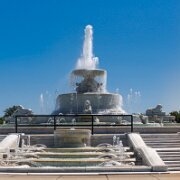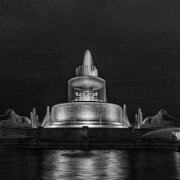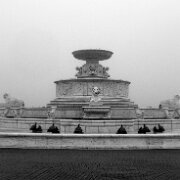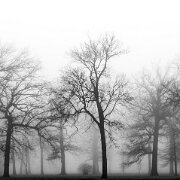
1 Belle Isle is a 982-acre (1.534 sq mi; 397 ha) island park in the Detroit River, between the United States mainland and Canada, managed by the Detroit Recreation Department. It is connected to the rest of Detroit, Michigan by the MacArthur Bridge. It is the largest island city park in the United States and the third largest island in the Detroit River after Grosse Ile and Fighting Island.
It is home to the Belle Isle Conservatory (1904), the Detroit Yacht Club on an adjacent island, the Detroit Boat Club, James Scott Memorial Fountain, the Dossin Great Lakes Museum, a Coast Guard station, and a municipal golf facility. The city maintains a Nature Center where visitors are able to traverse wooded trails and view wildlife natural habitats. The island includes a half-mile (800 m) swimming beach.
It is home to the Belle Isle Conservatory (1904), the Detroit Yacht Club on an adjacent island, the Detroit Boat Club, James Scott Memorial Fountain, the Dossin Great Lakes Museum, a Coast Guard station, and a municipal golf facility. The city maintains a Nature Center where visitors are able to traverse wooded trails and view wildlife natural habitats. The island includes a half-mile (800 m) swimming beach.

2 Belle Isle is a 982-acre (1.534 sq mi; 397 ha) island park in the Detroit River, between the United States mainland and Canada, managed by the Detroit Recreation Department. It is connected to the rest of Detroit, Michigan by the MacArthur Bridge. It is the largest island city park in the United States and the third largest island in the Detroit River after Grosse Ile and Fighting Island.
It is home to the Belle Isle Conservatory (1904), the Detroit Yacht Club on an adjacent island, the Detroit Boat Club, James Scott Memorial Fountain, the Dossin Great Lakes Museum, a Coast Guard station, and a municipal golf facility. The city maintains a Nature Center where visitors are able to traverse wooded trails and view wildlife natural habitats. The island includes a half-mile (800 m) swimming beach.
It is home to the Belle Isle Conservatory (1904), the Detroit Yacht Club on an adjacent island, the Detroit Boat Club, James Scott Memorial Fountain, the Dossin Great Lakes Museum, a Coast Guard station, and a municipal golf facility. The city maintains a Nature Center where visitors are able to traverse wooded trails and view wildlife natural habitats. The island includes a half-mile (800 m) swimming beach.

3 The Belle Isle Aquarium is a public aquarium located in Belle Isle Park in Detroit, Michigan. Designed by noted architect Albert Kahn, it opened on August 18, 1904, and was the oldest continually operating public aquarium in North America when it closed on April 3, 2005.[2] The aquarium reopened to the public on August 18, 2012, and is now run entirely by volunteers.

4 Belle Isle is a 982-acre (1.534 sq mi; 397 ha) island park in the Detroit River, between the United States mainland and Canada, managed by the Detroit Recreation Department. It is connected to the rest of Detroit, Michigan by the MacArthur Bridge. It is the largest island city park in the United States and the third largest island in the Detroit River after Grosse Ile and Fighting Island.
It is home to the Belle Isle Conservatory (1904), the Detroit Yacht Club on an adjacent island, the Detroit Boat Club, James Scott Memorial Fountain, the Dossin Great Lakes Museum, a Coast Guard station, and a municipal golf facility. The city maintains a Nature Center where visitors are able to traverse wooded trails and view wildlife natural habitats. The island includes a half-mile (800 m) swimming beach.
It is home to the Belle Isle Conservatory (1904), the Detroit Yacht Club on an adjacent island, the Detroit Boat Club, James Scott Memorial Fountain, the Dossin Great Lakes Museum, a Coast Guard station, and a municipal golf facility. The city maintains a Nature Center where visitors are able to traverse wooded trails and view wildlife natural habitats. The island includes a half-mile (800 m) swimming beach.

5 The James Scott Memorial Fountain in Detroit, Michigan, USA, was designed by architect Cass Gilbert and sculptor Herbert Adams. Located in Belle Isle Park, the fountain was completed in 1925 at a cost of $500,000. The lower bowl has a diameter of 510 ft (160 m) and the central spray reaches 125 ft (38 m). The fountain honors the controversial James Scott, who left $200,000 to the City of Detroit for a fountain in tribute to himself.

6 The James Scott Memorial Fountain in Detroit, Michigan, USA, was designed by architect Cass Gilbert and sculptor Herbert Adams. Located in Belle Isle Park, the fountain was completed in 1925 at a cost of $500,000. The lower bowl has a diameter of 510 ft (160 m) and the central spray reaches 125 ft (38 m). The fountain honors the controversial James Scott, who left $200,000 to the City of Detroit for a fountain in tribute to himself.

8 The Detroit Boat Club, established in 1839, is the second oldest continuously-operated sport rowing club in the United States. It was first created on the Detroit River during a time in which Detroit was just starting to grow.

9 The Detroit Boat Club, established in 1839, is the second oldest continuously-operated sport rowing club in the United States. It was first created on the Detroit River during a time in which Detroit was just starting to grow.

10 The Detroit Boat Club, established in 1839, is the second oldest continuously-operated sport rowing club in the United States. It was first created on the Detroit River during a time in which Detroit was just starting to grow.

11 William Livingstone Memorial Light
The white fluted marble 70-foot high tower is located on the north end of Belle Isle in the Detroit River. It is the only light in the nation constructed of marble.
Built in 1929 with private donations as a memorial to William Livingstone, who was the president of the Lakes Carriers Association from 1902 to 1925. The plaque on the tower explains that that the light is the gift of the citizens of Detroit and the Lakes Carriers Association.
Livingstone was a popular and prominent resident of Detroit. He is known for his promotion of many navigation improvements on the lakes, including the construction of the separate down-bound channel in the lower Detroit River, which is named after him.
The occulting light is visible for 16 miles to the east. It can be visited and photographed at the north end of Belle Isle in Detroit.
The white fluted marble 70-foot high tower is located on the north end of Belle Isle in the Detroit River. It is the only light in the nation constructed of marble.
Built in 1929 with private donations as a memorial to William Livingstone, who was the president of the Lakes Carriers Association from 1902 to 1925. The plaque on the tower explains that that the light is the gift of the citizens of Detroit and the Lakes Carriers Association.
Livingstone was a popular and prominent resident of Detroit. He is known for his promotion of many navigation improvements on the lakes, including the construction of the separate down-bound channel in the lower Detroit River, which is named after him.
The occulting light is visible for 16 miles to the east. It can be visited and photographed at the north end of Belle Isle in Detroit.

12 William Livingstone Memorial Light
The white fluted marble 70-foot high tower is located on the north end of Belle Isle in the Detroit River. It is the only light in the nation constructed of marble.
Built in 1929 with private donations as a memorial to William Livingstone, who was the president of the Lakes Carriers Association from 1902 to 1925. The plaque on the tower explains that that the light is the gift of the citizens of Detroit and the Lakes Carriers Association.
Livingstone was a popular and prominent resident of Detroit. He is known for his promotion of many navigation improvements on the lakes, including the construction of the separate down-bound channel in the lower Detroit River, which is named after him.
The occulting light is visible for 16 miles to the east. It can be visited and photographed at the north end of Belle Isle in Detroit.
The white fluted marble 70-foot high tower is located on the north end of Belle Isle in the Detroit River. It is the only light in the nation constructed of marble.
Built in 1929 with private donations as a memorial to William Livingstone, who was the president of the Lakes Carriers Association from 1902 to 1925. The plaque on the tower explains that that the light is the gift of the citizens of Detroit and the Lakes Carriers Association.
Livingstone was a popular and prominent resident of Detroit. He is known for his promotion of many navigation improvements on the lakes, including the construction of the separate down-bound channel in the lower Detroit River, which is named after him.
The occulting light is visible for 16 miles to the east. It can be visited and photographed at the north end of Belle Isle in Detroit.

13 The James Scott Memorial Fountain is a monument located in Belle Isle Park, in Detroit, Michigan. Designed by architect Cass Gilbert and sculptor Herbert Adams, the fountain was completed in 1925 at a cost of $500,000.[1] The lower bowl has a diameter of 510 ft (160 m) and the central spray reaches 125 ft (38 m). The fountain honors the controversial James Scott, who left $200,000 to the City of Detroit for a fountain in tribute to himself.

14 The Anna Scripps Whitcomb Conservatory (commonly and locally known as the Belle Isle Conservatory) is a greenhouse and a botanical garden located on Belle Isle, a 982-acre island park nestled in the Detroit River between Detroit and the Canada–United States border. The park itself consists of 13 acres of preserved land for the conservatory and its botanical garden.
Opened in 1904, the Anna Scripps Whitcomb Conservatory is the oldest continually-running conservatory in the United States.[1][2] It is named for Anna Scripps Whitcomb, who left her collection of 600 orchids to Detroit in 1955
Opened in 1904, the Anna Scripps Whitcomb Conservatory is the oldest continually-running conservatory in the United States.[1][2] It is named for Anna Scripps Whitcomb, who left her collection of 600 orchids to Detroit in 1955

19 Belle Isle, officially Belle Isle Park, is a 982-acre (1.534 sq mi; 397 ha) island park in the Detroit River, between the United States mainland and Canada. Owned by the City of Detroit, it is managed as a state park by the Michigan Department of Natural Resources through a 30-year lease initiated in 2013. Belle Isle is the largest city-owned island park in the United States and is the third largest island in the Detroit River after Grosse Ile and Fighting Island. It is connected to mainland Detroit by the MacArthur Bridge.
The island is home to the Belle Isle Aquarium, the Belle Isle Conservatory, the Belle Isle Nature Zoo, the Detroit Yacht Club on an adjacent island, the James Scott Memorial Fountain, the Dossin Great Lakes Museum, a Coast Guard station, a municipal golf course and numerous monuments. It also previously housed a Nature Center where visitors were able to traverse wooded trails and view wildlife natural habitats, a former Belle Isle Zoo, riding stables and the Detroit Boat Club. The island includes a half-mile (800 m) swimming beach.
The island is home to the Belle Isle Aquarium, the Belle Isle Conservatory, the Belle Isle Nature Zoo, the Detroit Yacht Club on an adjacent island, the James Scott Memorial Fountain, the Dossin Great Lakes Museum, a Coast Guard station, a municipal golf course and numerous monuments. It also previously housed a Nature Center where visitors were able to traverse wooded trails and view wildlife natural habitats, a former Belle Isle Zoo, riding stables and the Detroit Boat Club. The island includes a half-mile (800 m) swimming beach.

20 Belle Isle, officially Belle Isle Park, is a 982-acre (1.534 sq mi; 397 ha) island park in the Detroit River, between the United States mainland and Canada. Owned by the City of Detroit, it is managed as a state park by the Michigan Department of Natural Resources through a 30-year lease initiated in 2013. Belle Isle is the largest city-owned island park in the United States and is the third largest island in the Detroit River after Grosse Ile and Fighting Island. It is connected to mainland Detroit by the MacArthur Bridge.
The island is home to the Belle Isle Aquarium, the Belle Isle Conservatory, the Belle Isle Nature Zoo, the Detroit Yacht Club on an adjacent island, the James Scott Memorial Fountain, the Dossin Great Lakes Museum, a Coast Guard station, a municipal golf course and numerous monuments. It also previously housed a Nature Center where visitors were able to traverse wooded trails and view wildlife natural habitats, a former Belle Isle Zoo, riding stables and the Detroit Boat Club. The island includes a half-mile (800 m) swimming beach.
The island is home to the Belle Isle Aquarium, the Belle Isle Conservatory, the Belle Isle Nature Zoo, the Detroit Yacht Club on an adjacent island, the James Scott Memorial Fountain, the Dossin Great Lakes Museum, a Coast Guard station, a municipal golf course and numerous monuments. It also previously housed a Nature Center where visitors were able to traverse wooded trails and view wildlife natural habitats, a former Belle Isle Zoo, riding stables and the Detroit Boat Club. The island includes a half-mile (800 m) swimming beach.





Belle Isle